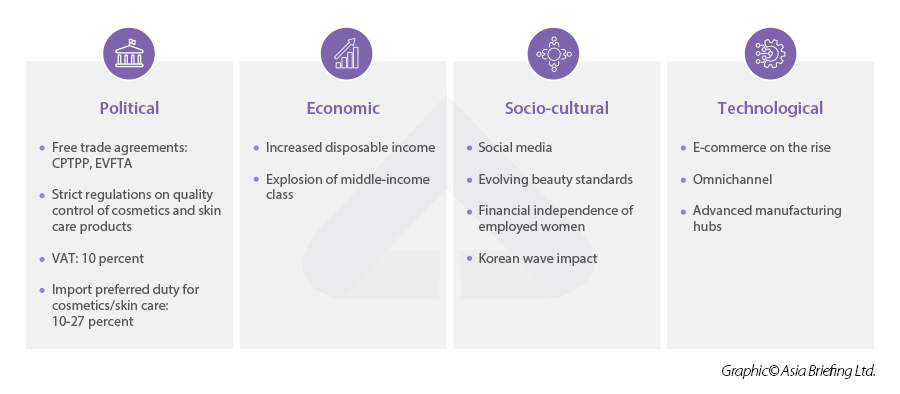Vietnam’s cosmetics market is rather young, yet is one of the most dynamic in the region. As living standards in Vietnam grow, Vietnamese consumers are becoming more aware of personal care and beauty products besides satisfying basic needs. With a market value of up to US$ 2.3 billion in 2021, Vietnam Briefing analyses the current situation, opportunities, and challenges for businesses entering this industry.
Cosmetics products are big business in Vietnam. The industry is booming thanks to a large number of Vietnamese consumers investing in personal care and beauty products given higher living standards.
Vietnam has risen to a middle-income from a low-income country, with an increasing middle-income class who are allocating more of their income to cosmetics products. A middle-class female in Vietnam spends an average of VND 450,000 – VND 500,000 (US$19 – US$21) monthly on makeup and skincare.
Growing disposable income, evolving beauty standards, the spread of social media, and the Korean wave all contribute to the soaring demand for beauty products in Vietnam.
South Korea is renowned for its skincare and makeup regime. Korean idols and influencers add fuel to self-care trends in Vietnam through social media, campaigns, advertisements, and beauty blogs. Moreover, greater financial independence for employed women in Vietnam has driven their demand for beauty care while evolving beauty standards has led males to pay more attention to grooming.
Since 2018, the percentage of women in Vietnam using cosmetics has climbed up from 76 percent to 86 percent. In the next decade, Vietnam’s cosmetics market is projected to witness a growth of 15-20 percent annually.
Vietnam’s skin care product market size totaled in value at US$850 million in 2019 and is anticipated to reach US$1.9 billion by 2027, indicating a CAGR of 11.7 percent during the 2021-2027 period.
See also: Getting Your Goods to Market in Vietnam (Free e-Book)
Overview of the cosmetics market
Vietnam is a hotspot for foreign cosmetics brands with up to 93 percent of personal care products imported. South Korea is the dominant cosmetics exporter to Vietnam, followed by Europe, Japan, Thailand, and the US.
| Country | Cosmetics import market share |
|---|---|
| South Korea | 30% |
| The EU | 23% |
| Japan | 17% |
| Thailand | 13% |
| The US | 10% |
Source: US Department of Commerce
Other exporters of beauty and personal care include Singapore and China. Meanwhile, domestic brands only represent less than 10 percent of total consumption. Domestic brands mainly focus on affordable, lower-end products that compete on price.
Foreign players’ dominance in the market is mainly due to the Vietnamese’s preference for imported products. Vietnamese consumers perceive foreign brands as having higher quality and a wider variety of products that can cater to individual needs.
Vietnam’s importation of beauty products was worth around US$950 million in 2019. The most prominent imports include facial cleansers, facial moisturizers, lipsticks for women, and grooming/shaving products for men.
The opening of various retail chains like Watsons, Guardian, and new players like Pharmacity and Matsumoto, has increased the reach of imported cosmetics products to middle-class and affluent consumers in Vietnam.
Meanwhile, recognizing the potential of the young, yet budding market of Vietnam, major and high-end foreign cosmetics companies have either opened representative offices or sold through agents and distributors such as:
- Unilever: constituting up to 12 percent of the market, famous brand: Pond’s
- Beiersdorf Vietnam: Nivea
- LG Vina Cosmetics: Ohui (high-end), The Face Shop
- AmorePacific Vietnam: Laneige, Innisfree
- L’Oreal Vietnam Co Ltd: L’Oreal
Some domestic brands like Thorakao, Saigon Cosmetic, Lana, Sao Thai Duong, and a new player, Cocoon, have gained some degree of reputation.
Revenue of the cosmetics market in Vietnam has been on a steady rise for all sectors since 2019, with implications for 2023.
Revenue over the years in US$ (millions):
| Year | Eyes | Face | Lips | Natural Cosmetics |
|---|---|---|---|---|
| 2019 | 141.7 | 103.7 | 112.9 | 49.5 |
| 2020 | 142 | 103.1 | 112.9 | 49.3 |
| 2021 | 153.5 | 110.9 | 122 | 53.2 |
| 2022f | 165.4 | 119.3 | 131.5 | 57.4 |
| 2023f | 177.6 | 128.3 | 141.4 | 61.9 |
Source: Statista
Eye and lip products are the two most dominant sectors of the market, generating over a US$100 million annually since 2018. The natural cosmetics sector is a weaker performer, yet holds immense growth potential in the medium term. Indeed, more people are shifting their focus to clean, organic, and herbal ingredients, which are believed to be both healthy and eco-friendly compared to chemical-based cosmetics.
To provide investors a panoramic view of the cosmetics and personal care market in Vietnam, we provide a PEST (Political, Economic, Social, and Technological) analysis below:
Opportunities and challenges for new and current players
Vietnamese people are becoming more health-conscious, and are paying close attention to the ingredients of beauty products in the market. This has opened up new opportunities for cosmetics companies wishing to extend beyond their current scope or newcomers wishing to enter Vietnam’s cosmetics and personal care market.
Investors should look to domestically produce and distribute organic beauty products for two main reasons.
First, Vietnam has relatively cheap organic and herbal ingredients that can serve beauty products. Coconut is one such ingredient that is abundant in Vietnam’s Mekong Delta region and is an essential element in many beauty products.
This is followed by turmeric, green tea, and aloe vera, three native ingredients in Vietnam with healing properties for damaged skin. Overall Vietnam is native to a wide range of organic ingredients - a good foundation for businesses that want to develop organic products domestically.
Secondly, the local consumer mindset is changing, with exceptional concern about the quality of personal care products, especially for Generation Z. Hence, organic and herbal products are likely to see immense growth in the beauty market. Big players are already making the change. L’Oreal, the market leader, has launched their popular Inoa hair dye which they claim to be oil-based and ammonia-free while Nivea by Beiersdorf has also introduced their natural skincare line.
Yet challenges remain. One big hindrance is that the cosmetics market in Vietnam is rather young and unstable. One big driver behind the high demand for cosmetics products is the Korean wave. However, Korean trends alternate radically from time to time, which has made the cosmetics market in Vietnam vulnerable to instability. Besides, the cosmetics market is also significantly influenced by Korean celebrity endorsements. Endorsing one product over another carries weight and influences the sales of products, adding to a company’s challenges.
Another challenge in the market is that it is highly price sensitive. Since a large proportion of consumers are young people with a lower income, they tend to go for products of the lower end rather than high-end products. To compete, it is important that cosmetics and personal care companies set their price range as close as possible to the buying power of Vietnamese consumers.
Vietnam’s cosmetics market also holds challenges for Western brands due to consumers’ stereotypes. Consumers believe Asian-made products are a better suit for their skin type than European-made products owing to physical differences.
However, the problem can be alleviated as long as Western brands show a strong commitment to quality since Vietnamese consumers are more concerned with quality ingredients.
What makes Vietnam’s market worth investing in?
For such a young market like Vietnam with a high tariff line for imported cosmetics and personal care products, the most asked question is: what makes Vietnam a worthwhile venture?
It is worth noting that Vietnam imposes a 10-27 percent tariff rate on cosmetics and personal care products while VAT is 10 percent. The import duty of beauty products is calculated on the CIF (cost, insurance, freight) value of each shipment. This tariff line is fairly high compared to other countries in the region.
High import duty has driven up the prices of most imported beauty products. Consumers have to spend at least US$3.42 (VND 80,000) to get an average shampoo product in Vietnam while in Germany the same shampoo product costs around US$2 (VND 46,000).
In light of such disparity in price range, Vietnamese spending on cosmetics and self-care products is even higher than consumers of developed countries. This implies Vietnamese consumers’ willingness to pay for high-quality products as well as high demand for beauty products – an opportunity for investors to look into this young, yet hungry-for imported products, market.
Basic requirements when exporting cosmetics to Vietnam
Imported cosmetics registration in Vietnam is under the authority of the Drug Administration of Vietnam (DAV), under the Ministry of Health (MOH). Every exporter and importer is required to obtain relevant certificates from these government bodies. All imported cosmetics and personal care products must be registered with the MOH, and the following information is required on the packaging:
- Name, functions of product;
- Listed ingredients formula;
- Usage guidance;
- Country of origin;
- Name and address of distributor (written in Vietnamese);
- Weight, volume;
- Manufacturing and expiry dates; and
- Manufacturing lot number.
Cosmetic notification procedure
Businesses that import and distribute cosmetics and personal care products in Vietnam should prepare the following documents:
- Two copies of the Notification form with the proclamation data;
- Legalized original or notarized copy of the Letter of Authorization from the product manufacturer or owner, allowing the registrant to distribute the products in the Vietnam market; and
- Legalized original or notarized copy of a valid certificate of free sale (CFS). However, the CFS will be exempted for products produced in a member country of the Comprehensive and Progressive Agreement for Trans-Pacific Partnership (CPTPP) or ASEAN countries.
The required documents are then submitted to the DAV online, via the Vietnam National Single Window. The fee for registration will be VND 500,000 (US$21,38). The process takes up to 7-10 working days for the DAV to issue the result: a receipt number, also considered as the product license number and is valid for 5 years since the issuance date.
Takeaways
The cosmetics market in Vietnam is still in its infancy, which poses both advantages and disadvantages for domestic and foreign players. But as skincare and cosmetics have become a daily ritual for many Vietnamese consumers, the market is projected to only grow in the long run. With abundant supplies of organic ingredients and rising demand, Vietnam is a budding market for cosmetics and personal care companies to enter.








